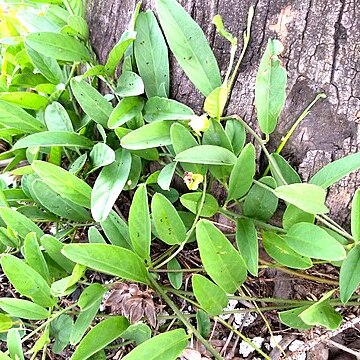Stems herbaceous, twining or prostrate, rooting in the basal parts (always?), to 1½ m long, terete, finely striate or smooth, appressed-pilose or glabrous. Leaves narrowly to broadly oblong 3½-7-1 (-11) by ¾-3(-5) cm, attenuate towards the base, obtuse, truncate or emarginate, and mucronulate at the apex, rarely acute, glabrous or sparsely pilose above, sparsely pilose or rarely glabrous beneath; petiole short, ½-2 cm. Peduncles 1-or sometimes 2-3-flowered, shorter than the leaves, 2-5 cm long, more or less densely pilose, often denser towards the top. Pedicels shorter than the outer sepals, 5-7 mm or slightly longer, appressed-pilose. Bracts small, narrow-lanceolate to subulate, acute. Sepals reticulately veined, the 3 outer ones 12-20 mm long, sparsely pilose outside; sepal 1 & 2 ovate, acute and mucronulate at the apex, rounded, slightly cordate or acute at the base, and shortly decurrent on the pedicel; sepal 3 lanceolate, more or less falcate, shortly decurrent; two inner sepals 10-13 mm long, ovate to lanceolate, acute or acuminate at the apex, not decurrent at the base; outer sepals enlarged in fruit, scarious, 2-2½ cm long. Corolla funnel-shaped, 2-3 cm long, white; limb shallowly 5-lobed; midpetaline bands hairy, with a hairy mucro; connecting fields glabrous. Filaments hairy at the base. Capsule ovoid, valves oblong, acute, brown outside, silvery white and shining inside. Seeds 4 or less, 5-6 mm diam., minutely pilose on the sides, woolly at the edges.
More
Vines; stems herbaceous, at least above, glabrous to sparsely pubescent. Leaves narrowly lanceolate, 4-8 cm long, obtuse to acute basally, obtuse and mucronate apically, entire, glabrate. Flowers mostly solitary in the leaf axils, peduncles to 5 cm long; sepals broadly ovate, the outer 2 broader than the inner 3, 12-17 mm long, acuminate; corollas white, campanulate, 25-30 mm long. Fruits capsular, ovoid, ca. 2 cm long, subtended by the enlarged calyx; seeds black, glabrous.
A small climber which is woody at the base. It is slender. It grows 1.5 m tall. It can grow from seed each year or keep growing from year to year. The leaf blades are narrowly sword shaped. They are 4-8 cm long by 2 cm wide. The flowers are white and bell shaped. The fruit is oval and 1.5-2 cm long. It has a large calyx around it. The seeds are 4-6 mm across.
In marshy grasslands, freshwater swamps, marshy thickets, along river-banks, edges of pools, at low altitudes.
More
A tropical plant. It can be in swamps or open forests. It grows near sea level. It is mostly near the coast.


